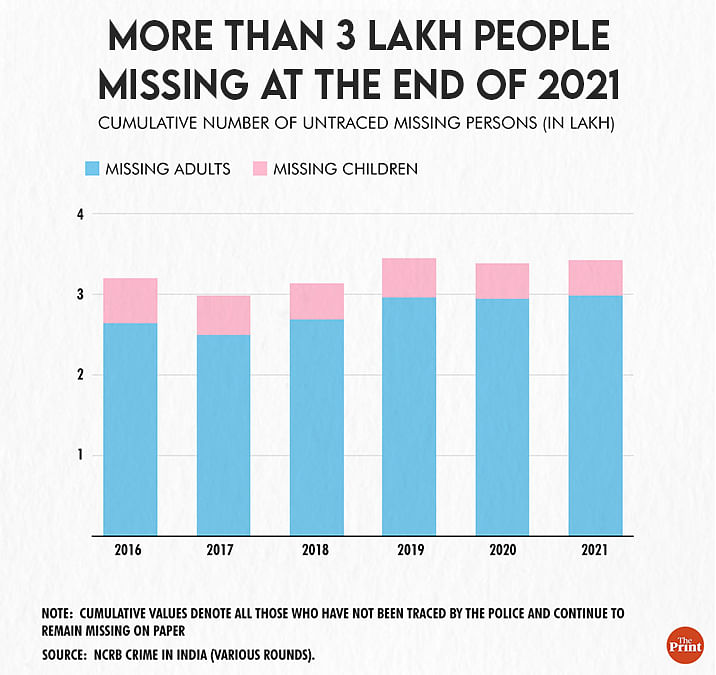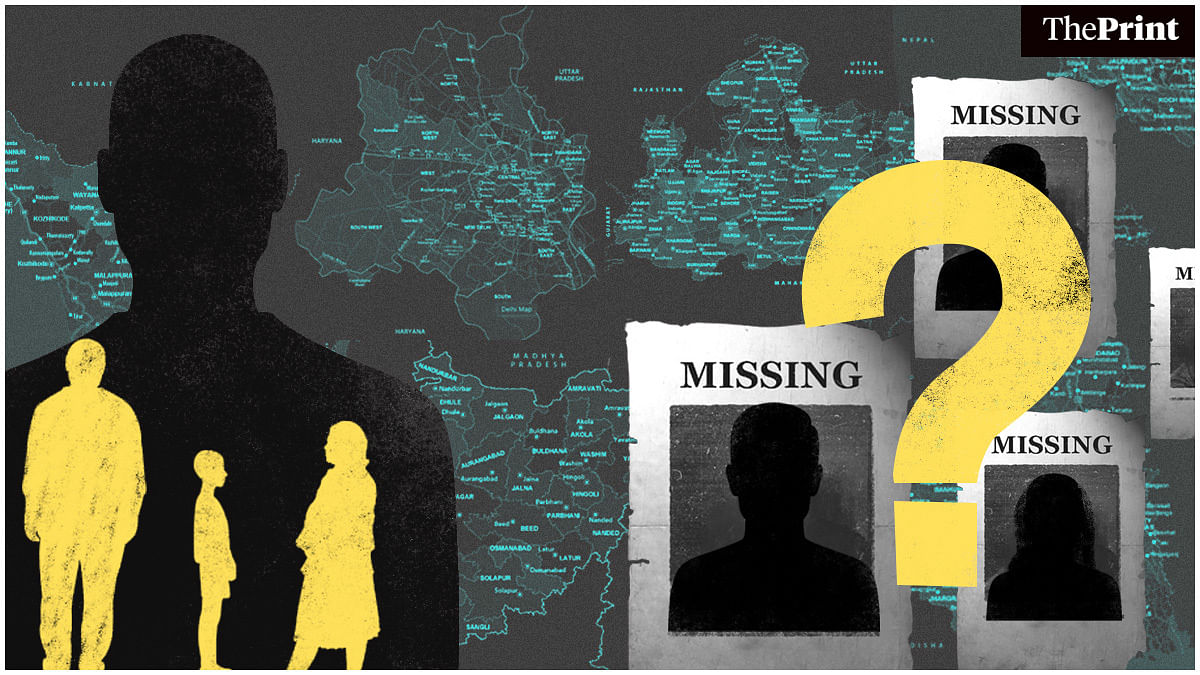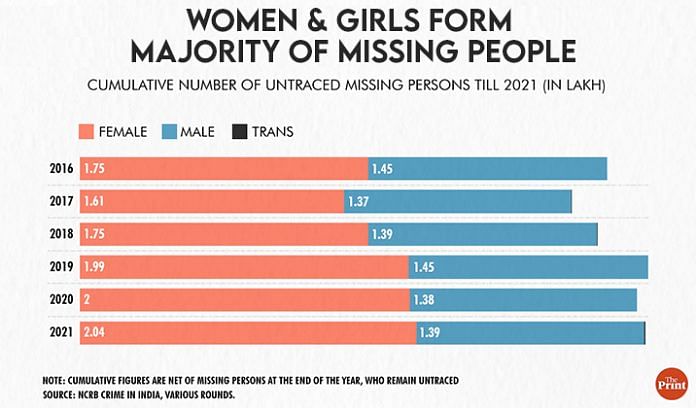New Delhi: The issue of missing persons has been brought into the spotlight due to the controversy surrounding the movie, The Kerala Story. ThePrint has dived into the available data to figure out what the accurate story is on India’s missing people.
The analysis reveals that the most people go missing in West Bengal, Madhya Pradesh, Maharashtra, and Delhi. On the flip side, Kerala is the most successful in tracing its missing people.
The National Crime Records Bureau (NCRB), India’s apex agency that collects crime data, includes information on missing persons reports filed in police stations.
According to the NCRB, at the end of 2021 (the latest period for which there is data), India had about 3.42 lakh people reportedly missing and still untraced. States such as West Bengal, Madhya Pradesh, Maharashtra and Delhi account for more than 50 per cent of these missing persons still untraced.
Also Read: Cruelty by husbands and their relatives makes up one-third of crimes against women in India: MoSPI
Most victims adults, females
The NCRB statistics show that of the 3.42 lakh people still missing and untraced, around 87 per cent or 2.98 lakh were adults — children accounting for only 13 per cent.
Since 2016, the share of children among untraced missing people has come down by 4 percentage points. In 2016, about 55,000 missing children formed 17 per cent of the total missing tally, which dropped to 16 per cent in 2017 and 14 per cent in 2018 and 2019.

By 2020, it came down to 13 per cent of the total missing lot and remained the same in 2021.
Data also shows that the number of missing women in the tally of untraced missing persons has risen over the years. In 2021, nearly two-thirds of all the untraced missing people were women (2 lakh out of 3.4 lakh).
In 2016, women constituted around 55 per cent of the missing persons’ tally. By 2021, they accounted for about 60 per cent of the untraced missing persons. A total of 60 transgender people were also reported missing and had not been traced by 2021.
Recovery rate
The NCRB also gives the recovery rate, which shows how many of the overall missing persons (including previous years) were traced — the number of people found in the said year divided by total number of missing persons.
Among the states that had the best record of reporting or tracing missing persons was Kerala. Of the about 11,000 who were missing by 2021, the state had traced about 9,452, or 86 per cent, in 2021.
Kerala is followed by Telangana where 85.3 per cent of the missing persons had been traced. Around two-thirds of the missing persons had been traced in Assam, Andhra Pradesh, Karnataka, Gujarat, Maharashtra, Himachal Pradesh and Tamil Nadu.
Data shows that of all the states, Punjab has the lowest recovery rate among the states with more than 1,000 missing persons. In 2021, 15,642 people were missing and only 2,601 were recovered. Hence, of the total untraced missing persons, Punjab has been able to find only 16 per cent of them.

Punjab’s untraced missing persons’ tally can mostly be attributed to the slow pace of finding missing persons. In 2021, of the 15,642 missing persons, around 12,000 were backlogs of previous years. In 2016, this backlog stood at 5,761, an indication that the probability of a missing person in Punjab being found is low.
Each year, about 3,000 people go missing in the state and only 70 per cent of them are traced (on an average 2016-21). The remaining 30 per cent keeps getting added to the next year’s missing tally, thus increasing the denominator every year in Punjab.
Punjab’s low rate of tracing missing persons could possibly be attributed to young adults fleeing homes for love, when their parents don’t agree, police sources in Punjab said.
“Mostly, when a couple that wants to marry against their parents’ wishes runs from their homes, their parents file an FIR and a missing case is reported. However, upon realisation that they have been married and haven’t come back, their FIR usually gets cancelled… Other than that, I don’t think there are bigger factors pushing missing people’s tally up,” a Punjab Police officer who wished not to be named told ThePrint.
Punjab is followed by Delhi, where more than 34,000 were untraced by 2021 and the recovery rate was just 33.5 per cent — Delhi was able to trace only 33.5 per cent of the missing persons it reported throughout.
Other states that have not been able to trace more than half their missing persons include Jammu and Kashmir at 38.9 per cent recovery rate, Uttar Pradesh at 39.5 per cent, Chhattisgarh at 42.9 per cent, Bihar at 43.9 per cent, West Bengal at 44.5 per cent and Odisha at 49.2 per cent.
Figures understated?
The NCRB statistics are based on the cases that have been officially reported. According to Amod Kanth, a retired IPS officer and a social activist working for the homeless and missing children, believes that the figures for missing men are usually understated.
“When a woman goes missing, it is taken seriously by her parents,” Kanth told ThePrint. “Women are considered as valuables, so when she goes missing, it does get reflected in the data.”

“But this is not the case of hundreds of thousands of adult males, who simply run away from their house in the pursuit of economic opportunities,” he added. “During my service, we discovered 4,000 children involved in labour in just the vicinity of Jaipur, who were driven to cities by destitution. In so many districts of Uttar Pradesh and Bihar, adult males simply go from their villages to the cities, and dwell as homeless — no data gets collected unless a Census happens.”
Kanth also said that the police started taking missing children’s cases more seriously in 2013 after the Supreme Court considered children missing for more than two days as kidnapped.
“Police seldom took missing children cases sedulously, but when the court made it a cognisable offence, they were forced to investigate and this brought recovery up to 70 per cent in Delhi,” Kanth added.
(Edited by Smriti Sinha)
Also read: Serial killers and gore now have a growing base in India — on Netflix, Instagram, Spotify



